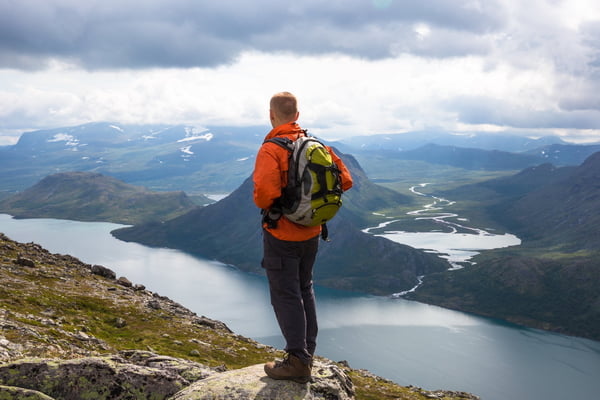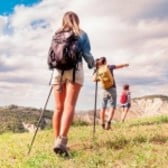
Trekking News
6 years, Australia
Opinion: The ‘Home of the Giants’ Is for You, Too
In Norway, camping in the wild is a right
JOTUNHEIMEN NATIONAL PARK, Norway — The Besseggen ridge juts from the earth as a curved spine of sharp, dark-gray stone and carves its way between two blue lakes in Jotunheimen, one of Norway’s many spectacular, wild national parks. “Jotunheimen” translates as “home of the giants,” and everything here is oversize, including the lakes. They are separated only by a narrow slice of the ridge yet have very distinct colors: Gjende is a long sweep of aquamarine; Bessvatnet is a dark royal blue.
Besseggen, a worthy destination for its otherworldly beauty alone, is also immortalized in national lore. Norway’s tourism board claims that Thor, the ill-tempered Norse warrior king, forged it by slamming his hammer into the earth. Henrik Ibsen, the country’s most celebrated playwright, described the ridge at length in his fantastical “Peer Gynt”: “Nigh on four miles long it stretches sharp before you like a scythe,” exalts the main character riding a reindeer over it.
 A hiker on Besseggen ridge.CreditCreditLkoimages/iStock, via Getty Images Plus
A hiker on Besseggen ridge.CreditCreditLkoimages/iStock, via Getty Images Plus
Every summer, tens of thousands of tourists walk the length of Besseggen. My husband and I set out on the hike last year, with plans to start late and camp in the wild somewhere on the trail leading to the ridge. For all its popularity, the eight-hour walk is strenuous, even mildly dangerous: As we ascended, we passed at least two limping hikers with bloodied knees and twisted ankles, assisted by irritated-looking relatives. It was August, but this was Norway. Even summer can be cold here, and as the sun drained from the sky, so did the color from the frigid stragglers’ faces.
By 8 p.m., exhausted by the climb, it occurred to us that we were overstretched. The official signboard into the park had offered few directives except a breezy instruction to camp where we wanted to and clean up after ourselves. But we had seen no reasonable place to pitch a tent; the terrain was all sharp boulder climbs and fields of jagged rocks. The sky turned dark gray as we crossed paths with two Norwegian Red Cross workers on a last sweep of the path, looking for injured tourists. Yet they appeared unconcerned that we were loitering on the trail. Great camping spots were to be found ahead, they assured us.
As we continued to climb, I thought about Ibsen. He is famous for his shattering works on difficult women, helming the advent of theatrical realism and fathering a prime minister. He is less known for popularizing, possibly coining, the term “friluftsliv,” or “open air life,” in his 1859 poem “On the Heights.” The expression perfectly captures a deeply entrenched Norwegian value that prizes outdoor recreation for its benefits to health and well-being, and represents a broader philosophy celebrating freedom and simplicity.
Friluftsliv has a companion concept: “allemannsrett,” the ancient Norse right to roam uncultivated countryside, even if it is privately owned, a tradition so ingrained it was codified in 1957 in the Outdoor Recreation Act. The law — which permits anyone to walk on public or private land and to camp for the night, so long as one remains 150 meters from private houses and behaves considerately — means that Norway offers tourists a curiously unregulated experience, rare among Western countries, except elsewhere in Scandinavia.
It was nearly 10 p.m. when we found ourselves at the peak of the ridge staring down at the enormous stone vertebrae and the two lakes. The evening arctic light had settled into a permanent, muted dusk, and ahead — far ahead — we could just make out a few tents in a large, grassy camping spot. We guessed the site was another 90 minutes away, down the ridge’s sharp descent.
Four robust Danish men suddenly appeared behind us and exclaimed profanities in unison when they realized they faced the same choice as we did: Walk until midnight, or camp here, on a stony ledge exposed to the whipping winds, atop one of Norway’s star attractions.
As my husband and I pitched our tent, I thought about how rare Norway’s laissez-faire approach to the outdoors is. To hike and camp along wilderness trails in the United States, I had to apply for multiple permits and was forbidden to tread on any private land. In Australia, camping is strictly regulated and often astoundingly expensive. The rules in Canada can be forbiddingly confusing. Extraordinary hiking trails stretch like arteries throughout Europe. But Germany, Denmark, Spain, the Netherlands, Portugal, Italy, Scotland, England and Wales, among other places, ban wild camping or impose complicated restrictions. Two years earlier, I had hiked for three months through Spain: I would wait until dusk each evening to wild-camp illegally, sleep little and move on before dawn, worried I would get caught.
Demand for walking holidays is steadily growing. The number of hikers on Europe’s famed Camino de Santiago increased from nearly 115,000 to more than 300,000 a year between 2007 and 2017. But they are increasingly corralled into organized campgrounds or small refuges, hostels or inns. The lodgings are marketed as a means to commune with nature without the inconveniences of heavy backpacks, cold tents and questionable hygiene. Yet they often embody the antithesis of friluftsliv: expensive, with catered meals and bunk-bed accommodation. Just one accomplished snorer will eviscerate any easing of the mind and soul gained through hiking the day before.
Places that ban wild camping seem to believe that travelers cannot be trusted. Sometimes this is true, because humans have lit ruinous fires, tossed litter and trampled delicate ecosystems. But during the nine days that we hiked through Jotunheimen, permitted to light fires, swim in the rivers, forage for mushrooms and pitch our tent wherever we pleased, we saw only land that was startlingly pristine.
That night in my sleeping bag on Besseggen, as the temperature plunged below freezing and I shivered and then shook, I marveled at the gift that Norway had bestowed upon us. We were cold and uncomfortable, but we slept untethered in the midst of a national treasure, at no charge.
n the morning, we ate oatmeal, cooked over a gas fire, while staring at the view. In a few hours, Scandinavian families, tour groups from China and couples from Germany in matching Birkenstocks would climb over these rocks, take selfies and eat packed sandwiches. But for now, we were alone, in silence. We checked that we left nothing behind and continued down the ridge toward the lakes below, each shimmering its own distinct blue.
by Danielle Moylan
This article first appeared on http://www.nytimes.com. The original can be read here.





